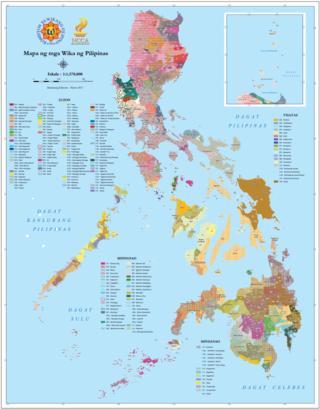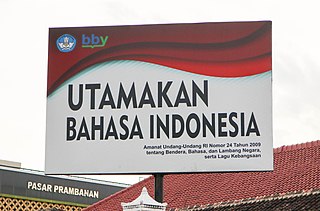Related Research Articles

Arabic is a Central Semitic language of the Afroasiatic language family spoken primarily in the Arab world. The ISO assigns language codes to 32 varieties of Arabic, including its standard form of Literary Arabic, known as Modern Standard Arabic, which is derived from Classical Arabic. This distinction exists primarily among Western linguists; Arabic speakers themselves generally do not distinguish between Modern Standard Arabic and Classical Arabic, but rather refer to both as al-ʿarabiyyatu l-fuṣḥā or simply al-fuṣḥā (اَلْفُصْحَىٰ).

Mandarin is a group of Chinese language dialects that are natively spoken across most of northern and southwestern China and Taiwan. The group includes the Beijing dialect, the basis of the phonology of Standard Chinese, the official language of China and Taiwan. Because Mandarin originated in North China and most Mandarin dialects are found in the north, the group is sometimes referred to as Northern Chinese. Many varieties of Mandarin, such as those of the Southwest and the Lower Yangtze, are not mutually intelligible with the standard language. Nevertheless, Mandarin as a group is often placed first in lists of languages by number of native speakers.
Chinook may refer to:

Pakistan is a multilingual country with over 70 languages spoken as first languages. The majority of Pakistan's languages belong to the Indo-Iranian group of the Indo-European language family.

There are some 130 to 195 languages spoken in the Philippines, depending on the method of classification. Almost all are Malayo-Polynesian languages native to the archipelago. A number of Spanish-influenced creole varieties generally called Chavacano along with some local varieties of Chinese are also spoken in certain communities. The 1987 constitution designates Filipino, a standardized version of Tagalog, as the national language and an official language along with English. Filipino is regulated by Commission on the Filipino Language and serves as a lingua franca used by Filipinos of various ethnolinguistic backgrounds.
BAI or Bai may refer to:

The Bisayan languages or Visayan languages are a subgroup of the Austronesian languages spoken in the Philippines. They are most closely related to Tagalog and the Bikol languages, all of which are part of the Central Philippine languages. Most Bisayan languages are spoken in the whole Visayas section of the country, but they are also spoken in the southern part of the Bicol Region, islands south of Luzon, such as those that make up Romblon, most of the areas of Mindanao and the province of Sulu located southwest of Mindanao. Some residents of Metro Manila also speak one of the Bisayan languages.
The Ngero–Vitiaz languages form a linkage of Austronesian languages in northern Papua New Guinea. They are spoken, from west to east, in Madang Province, Morobe Province, and New Britain.

The Fuzhou language, also Foochow, Hokchew, Hok-chiu, or Fuzhounese, is the prestige variety of the Eastern Min branch of Min Chinese spoken mainly in the Mindong region of Eastern Fujian Province. As it is mutually unintelligible to neighbouring varieties in the province, under a technical linguistic definition Fuzhou is a language and not a dialect. Thus, while Fuzhou may be commonly referred to as a 'dialect' by laypersons, this is colloquial usage and not recognised in academic linguistics. Like many other varieties of Chinese, the Fuzhou dialect is dominated by monosyllabic morphemes that carry lexical tones, and has a mainly analytic syntax. While the Eastern Min branch it belongs to is relatively closer to other branches of Min such as Southern Min or Pu-Xian Min than to other Sinitic branches such as Mandarin, Wu Chinese or Hakka, they are still not mutually intelligible.
BCU may refer to:

Microsoft Bing, commonly referred to as Bing, is a search engine owned and operated by Microsoft. The service traces its roots back to Microsoft's earlier search engines, including MSN Search, Windows Live Search, and Live Search. Bing offers a broad spectrum of search services, encompassing web, video, image, and map search products, all developed using ASP.NET.
Jarai is a Malayo-Polynesian language spoken by the Jarai people of Vietnam and Cambodia. The speakers of Jarai number approximately 530,000, not including other possible Jarai communities in countries other than Vietnam and Cambodia such as United States of America. They are the largest of the upland ethnic groups of Vietnam's Central Highlands known as Degar or Montagnards, and 25 per cent of the population in the Cambodian province of Ratanakiri.

Indonesia is home to over 700 living languages spoken across its extensive archipelago. This significant linguistic variety constitutes approximately 10% of the world’s total languages, positioning Indonesia as the second most linguistically diverse nation globally, following Papua New Guinea. The majority of these languages belong to the Austronesian language family, prevalent in the western and central regions of Indonesia, including languages such as Acehnese, Sundanese, and Buginese. In contrast, the eastern regions, particularly Papua and the Maluku Islands, are home to over 270 Papuan languages, which are distinct from the Austronesian family and represent a unique linguistic heritage. The language most widely spoken as a native language is Javanese, primarily by the Javanese people in the central and eastern parts of Java Island, as well as across many other islands due to migration.

Mīrā Anwar ‘Awaḍ is an Arab-Israeli singer-songwriter, actress, television host, and political activist of Palestinian Arab and Bulgarian descent.

Microsoft Translator or Bing Translator is a multilingual machine translation cloud service provided by Microsoft. Microsoft Translator is a part of Microsoft Cognitive Services and integrated across multiple consumer, developer, and enterprise products, including Bing, Microsoft Office, SharePoint, Microsoft Edge, Microsoft Lync, Yammer, Skype Translator, Visual Studio, and Microsoft Translator apps for Windows, Windows Phone, iPhone and Apple Watch, and Android phone and Android Wear.
Bing most often refers to:

Tai Yo, also known as Tai Mène and Nyaw, is a Tai language of Southeast Asia. It is closely related to Tai Pao of Vietnam, where it may have originated. It was once written in a unique script, the Tai Yo script, but that is no longer in use. The language is known regionally in Laos and Thailand as Tai Mène and Tai Nyaw and, in Vietnam as Tai Do and Tai Quy Chau. Superficially, Tai Yo appears to be a Southwestern Tai language but this is only because of centuries of language contact and it is properly classified with the Northern Tai languages. The Nyaw/Nyo spoken in central Thailand and western Cambodia is not the same as Tai Yo.
Feminist post-structuralist discourse analysis (FPDA) is a method of discourse analysis based on Chris Weedon's theories of feminist post-structuralism, and developed as a method of analysis by Judith Baxter in 2003. FPDA is based on a combination of feminism and post-structuralism. While it is still evolving as a methodology, FPDA has been used by a range of international scholars of gender and language to analyse texts such as: classroom discourse, teenage girls' conversation, and media representations of gender. FPDA is an approach to analysing the discourse of spoken interaction principally.

The Bikol languages or Bicolano languages are a group of Central Philippine languages spoken mostly in the Bicol Peninsula in the southeastern part of Luzon, the neighboring island-province of Catanduanes, and the island of Burias in Masbate.
References
- ↑ Awad Bing at Ethnologue (18th ed., 2015) (subscription required)